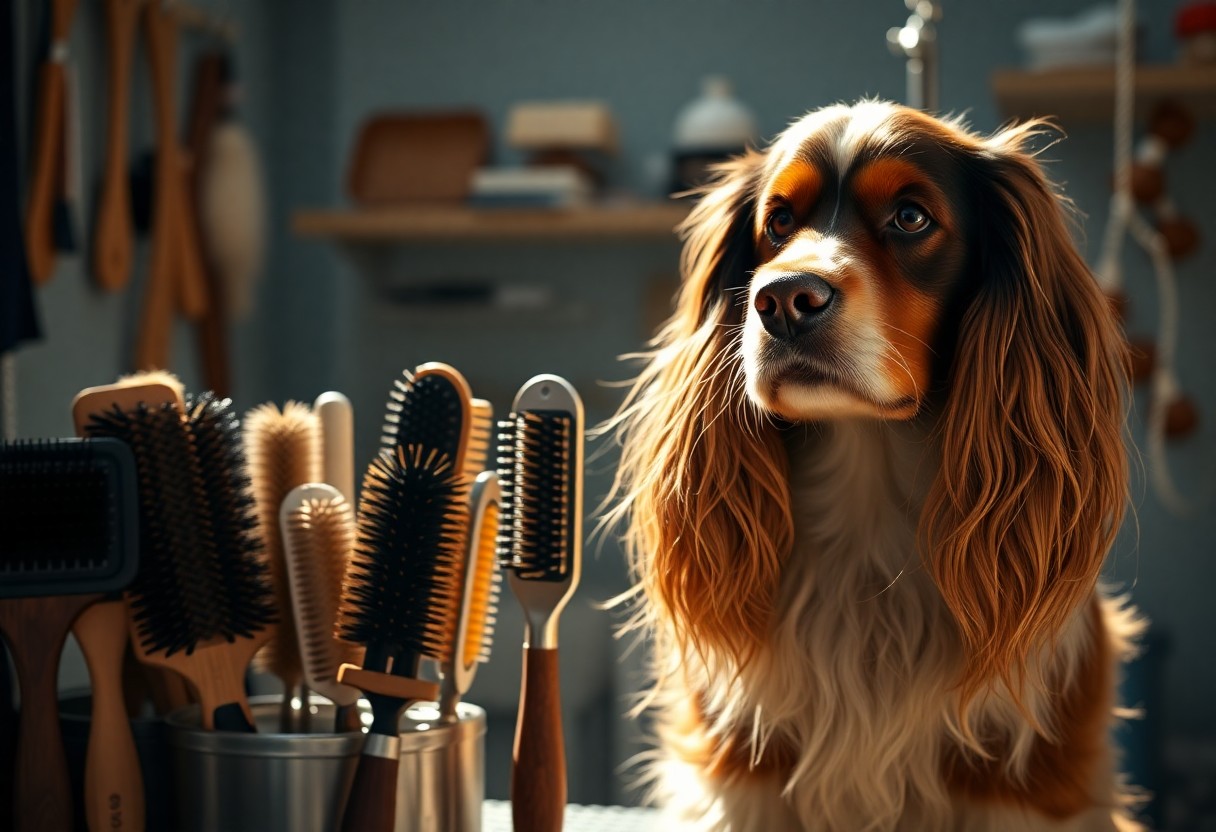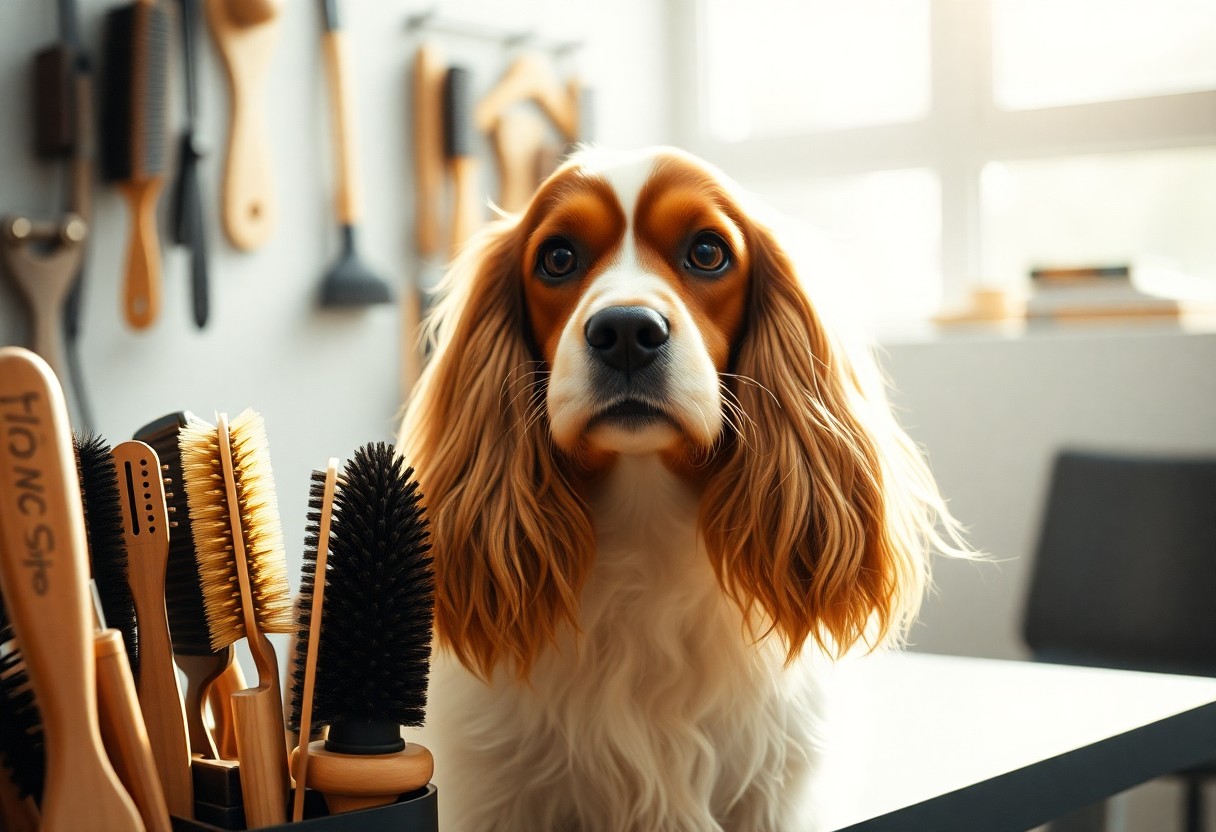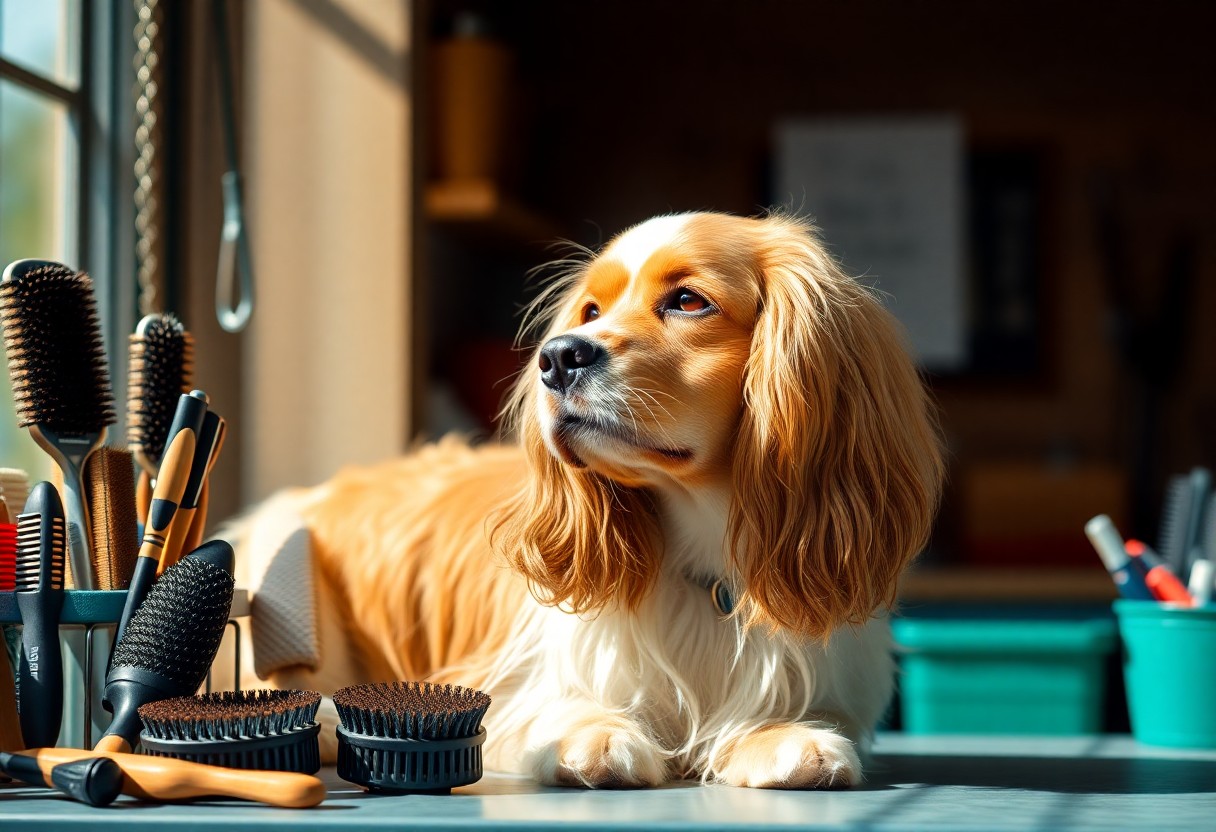Over time, maintaining your Spaniel’s long, lush coat can become a challenge, but with the right tools, you can make this grooming task easier and more enjoyable. Choosing the best dog brushes is crucial to prevent matting and reduce shedding, ensuring your furry friend stays healthy and comfortable. In this guide, you will discover various brush types perfect for Spaniels, how they work, and tips on how often you should groom your dog to keep their coat looking vibrant and clean.
Key Takeaways:
- Spaniels with long hair benefit from a slicker brush to help remove tangles and mats effectively.
- A pin brush is ideal for maintaining the coat’s natural shine and distributing natural oils.
- Regular grooming sessions, at least a few times a week, are imperative to manage shedding and prevent matting.
- Using a comb in conjunction with brushes can help address smaller tangles and ensure a thorough grooming process.
- High-quality dog brushes are designed to be gentle on the skin, reducing the risk of irritation during grooming.
- Consider ergonomic handles for added comfort, especially if grooming your Spaniel frequently.
- Investing in waterproof grooming tools can be beneficial for easy cleaning and maintenance after baths or outdoor activities.
Understanding Spaniel Coat Types
Before choosing the right brush for your Spaniel, it’s important to understand their unique coat types. Spaniels have long, flowing fur that requires specific care techniques to keep it healthy. Here are the key characteristics:
- Texture: Soft and silky
- Length: Long hair
- Undercoat: Abundant and thick
- Shedding: Moderate to high
- Common breeds: Cavalier King Charles, American, English
Any grooming routine will benefit from the best brushes for long-haired pets, suited to your Spaniel’s specific needs.
| Coat Type | Description |
| Silky | Soft, long hair requiring regular brushing. |
| Wavy | Flowy coat, may mat if not groomed frequently. |
| Curly | Dense and can trap debris; requires special tools. |
| Flat | Smooth and sleek coat; easy to detangle. |
| Double Coat | Thicker undercoat; needs thorough grooming. |
Characteristics of Long Hair
Characteristics of long hair in Spaniels include a beautiful, flowing coat that shows off their elegant appearance but requires diligent care. Long hair is prone to tangles and mats, particularly in areas where friction occurs, such as behind the ears and under the legs. Regular brushing prevents these issues and promotes healthy skin by distributing natural oils throughout the fur.
Importance of Regular Grooming
Understanding the importance of regular grooming cannot be overstated. Regular grooming helps keep your Spaniel’s coat clean and free of tangles, reducing the risk of skin problems. It also allows you to check for parasites like fleas or ticks, which can harm your dog’s health. Keeping a consistent grooming schedule can also create a stronger bond between you and your pet. To maintain your Spaniel’s healthy coat, aim for grooming sessions at least once or twice a week, using tools designed for long hair. This not only nurtures their coat but also contributes to your dog’s overall well-being.
Essential Features of Dog Brushes
It’s important to choose the right brush for your spaniel’s long hair. Consider key features such as bristle type, grip comfort, and grooming ease. A good brush will help reduce matting and keep their coat healthy. For more insights on different brush types, check out The 10 Best Dog Brushes, Tested and Reviewed.
Bristle Types and Their Benefits
At selecting the right brush, understanding the different bristle types can enhance your grooming experience:
| Bristle Type | Benefits |
| Pin Brush | Detangles long hair and removes loose fur. |
| Slicker Brush | Eliminates mats and controls shedding. |
| Bristle Brush | Ideal for smoothing and adding shine. |
| Undercoat Rake | Targets loose undercoat and reduces tangles. |
| Rubber Brush | Gentle for sensitive skin, great for short hair. |
Thou can choose any of these brushes based on specific grooming needs.
Handle Design for Comfort and Control
To ensure a comfortable grooming session, look for brushes with ergonomic handles that enhance your grip and control. A thoughtfully designed handle can reduce strain on your hand, allowing you to groom your spaniel without fatigue.
Brushes with non-slip grips and contoured designs provide you optimum comfort. The right handle design allows for precise strokes, helping you manage tangled fur more effectively. Additionally, a lightweight brush will make grooming sessions longer and more enjoyable for both you and your spaniel, ensuring that you can keep their coat healthy and mat-free with ease.
Top Recommended Brushes for Spaniels
All Spaniel owners know the importance of using the right brush to keep your dog’s long hair healthy and mat-free. With a variety of brushes available on the market, finding the best one can be overwhelming. Here, we’ve compiled a list of the most effective brushes specifically designed to cater to the unique needs of your Spaniel’s long, flowing coat.
Best Detangling Brushes
Against the odds of stubborn mats and tangles, investing in a quality detangling brush can save you and your Spaniel a lot of hassle. These brushes effectively glide through the fur, loosening knots without pulling or causing discomfort, making grooming sessions much more pleasant for both of you.
Best Undercoat Rakes
Behind every beautiful Spaniel coat is the need to properly manage its undercoat. An undercoat rake is your best friend in this case, allowing you to remove loose fur without damaging the longer top layer. Utilizing this tool will help you maintain a healthy coat for your Spaniel.
Even using an undercoat rake can significantly improve the general welfare of your Spaniel’s coat. These rakes feature wide, spaced teeth that penetrate the undercoat to remove excess shedding while minimizing irritation to the skin. Using this tool regularly will not only help in preventing painful matting but also promote a healthier and shinier coat. Choose a rake that is suitable for your Spaniel’s coat length and thickness to ensure the best results.
Grooming Techniques for Long-Haired Spaniels
After acquiring the right tools, mastering grooming techniques for your long-haired Spaniel is imperative for keeping their coat healthy and free of mats. Regular grooming not only enhances their appearance but also promotes bonding time between you and your pet. Start by establishing a grooming routine that includes brushing, bathing, and checking for any skin issues. This helps to maintain their coat’s natural oils and keeps their skin healthy.
Bathing and Drying Tips
Bathing your Spaniel effective requires the right approach to ensure a clean and healthy coat. Follow these tips for a successful bathing experience:
- Use a gentle, dog-specific shampoo to avoid skin irritation.
- Thoroughly rinse your Spaniel to remove all shampoo residue.
- Dry your dog using a microfiber towel or a pet-safe blow dryer on low heat.
- Ensure to dry behind the ears and in skin folds to prevent moisture buildup.
After following these tips, you’ll see a noticeable difference in your dog’s coat and overall comfort.
Brushing Methods for Maximum Effectiveness
Any effective brushing technique relies on the right tools and methods to groom your long-haired Spaniel properly. Start with a slicker brush to detangle and remove loose hair, then follow up with a bristle brush to smooth the coat and distribute natural oils. This combination helps maintain a sleek appearance while minimizing dirt buildup. Regular brushing sessions can also help you to spot any potential issues early on, such as skin irritations or parasites.
Also, try to incorporate a routine of brushing at least two to three times a week. This not only prevents mats and tangles but also leaves your Spaniel with a shiny and healthy coat. Use long, gentle strokes and pay extra attention to common matting areas such as behind the ears and under the legs. By investing time in this process, you can ensure your dog’s coat remains in top shape, and your Spaniel will appreciate the extra attention!
Maintaining Brush Hygiene
Once again, keeping your dog brushes clean is imperative for your Spaniel’s health and coat quality. Regularly maintaining brush hygiene helps prevent skin irritations and reduces the risk of spreading dirt and allergens. This simple routine ensures that your dog’s grooming experience is enjoyable and effective.
Cleaning Your Dog Brush
Any time you groom your Spaniel, make it a habit to remove hair and debris from your brush. Use a comb or your fingers to pull out fur and then wash the bristles in warm, soapy water. Rinse thoroughly and let your brush dry completely before the next use to keep it germ-free and functional.
When to Replace Your Brushes
On occasion, you’ll need to assess whether your dog brushes are still effective. Look for signs such as bent bristles, broken handles, or worn-out pads that may not perform well anymore. If your brush isn’t working efficiently, it’s time for an upgrade.
And when evaluating your brushes, consider that damaged brushes not only fail to groom your dog’s coat effectively, but they can also cause skin irritation, leading to discomfort. Regularly updating your tools ensures a positive grooming experience and helps maintain your Spaniel’s coat health. Investing in high-quality brushes will provide better results and keep your dog looking their best.
Professional Grooming vs. Home Grooming
Keep in mind that while home grooming provides convenience and savings, professional grooming often delivers superior results. Many dog owners find the experience beneficial as it allows for thorough cleaning and de-shedding. You can explore The 15 Best Dog Brushes, Tested by Pet Parents to help you with equipment. Depending on your Spaniel’s needs, you may find yourself weighing the pros and cons of each method.
Benefits of Professional Grooming
Across the board, professional grooming offers a comprehensive approach to maintaining your Spaniel’s coat. Experts specialize in handling various coat types and can identify skin issues that may go unnoticed at home. Additionally, they often use high-quality products that cater to your dog’s specific needs, ensuring a polished look.
Cost Considerations and Frequency
Among various factors, the cost of professional grooming can add up quickly, especially for a breed like Spaniels with long hair that requires frequent attention. You might need a grooming session every 6 to 8 weeks, leading to substantial annual expenses. However, it’s an investment in your dog’s health and happiness.
Professional grooming ensures that your Spaniel receives meticulous attention from trained experts who understand the necessary techniques and products tailored for long-haired breeds. While the costs may seem high, think of it as a way to avoid potential issues like matting and skin irritation, which can arise from inadequate home maintenance. Regular professional grooming not only guarantees a beautiful coat but also promotes your dog’s overall well-being, making it a worthwhile consideration.
Summing up
Now that you know the best dog brushes for Spaniels with long hair, you can ensure your furry friend stays looking their best. Choosing the right tools, such as slicker brushes, pin brushes, and grooming gloves, will help you manage tangles and maintain a healthy coat. Regular grooming not only promotes hygiene but also strengthens your bond with your Spaniel. By investing in quality grooming tools, you can make the grooming experience enjoyable for both you and your pet, leading to a beautiful and manageable coat.
FAQ
Q: Why do Spaniels with long hair require specific brushes?
A: Spaniels with long hair have a unique coat structure that often includes a combination of soft undercoat and long, wavy outer hair. This specific texture can trap dirt, debris, and tangles, making it necessary to use specialized brushes designed to reach both layers of fur effectively and maintain a healthy coat.
Q: What type of brush is best for detangling long hair on Spaniels?
A: A slicker brush is often recommended for detangling long hair on Spaniels. Its fine, short wires are effective at loosening tangles without damaging the coat. Additionally, using a comb with wide teeth followed by a finer-toothed comb can help ensure thorough detangling.
Q: How often should I brush my Spaniel’s long hair?
A: It is ideal to brush your Spaniel with long hair at least 2 to 3 times a week to avoid matting and to manage shedding. During shedding seasons, daily brushing may be necessary to keep the coat in optimal condition and to reduce hair around the house.
Q: Should I use a specific kind of brush for bathing my Spaniel?
A: Yes, a rubber curry brush can be beneficial when bathing your Spaniel. This type of brush helps to remove loose fur and dirt while the dog is wet, and the rubber material can be gentle on their skin. After bathing, a slicker brush can help remove any remaining tangles as the coat dries.
Q: Can I use human hair brushes on my Spaniel?
A: It is not advisable to use human hair brushes on dogs. Human brushes are designed for hair texture and growth patterns that differ significantly from those of dog coats. Using dog-specific brushes ensures you are caring for your pet’s unique hair needs properly, reducing the risk of injuring their skin or causing discomfort.
Q: What features should I look for in a quality dog brush for Spaniels?
A: When dicking out a dog brush for Spaniels, look for features such as ergonomic handles for comfort, durable materials for longevity, and specific bristle types for different coat textures. Brushes with stainless steel pins and flexible heads are also beneficial for effectively removing loose fur without causing irritation.
Q: Are there any additional grooming tools I should consider for my long-haired Spaniel?
A: Yes, in addition to a brush, consider using a dematting tool, an undercoat rake, and a grooming comb. A dematting tool is designed to tackle more severe tangles, while an undercoat rake helps to remove loose undercoat fur. A grooming comb can also help with finishing touches and is useful for sensitive areas like ears and paws.


